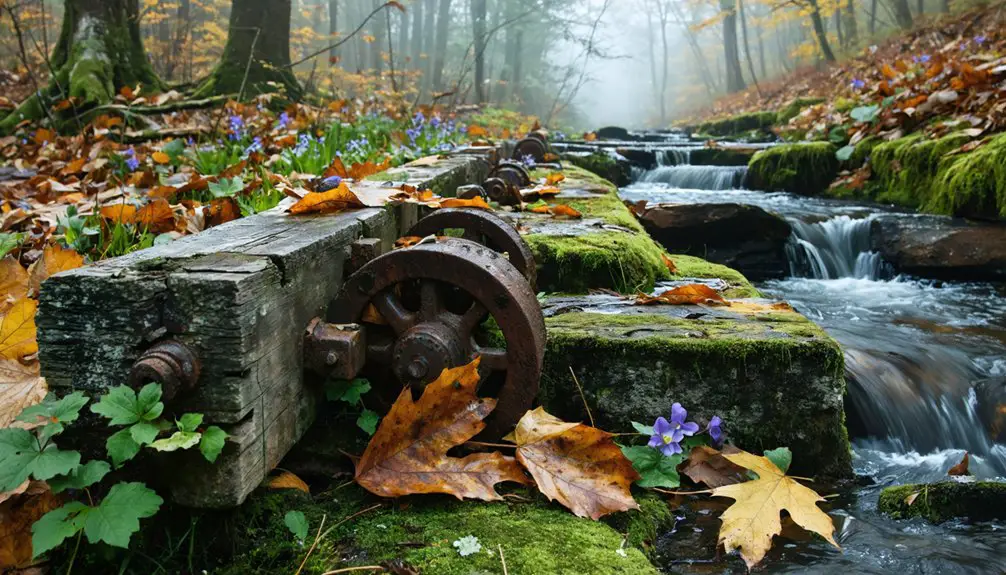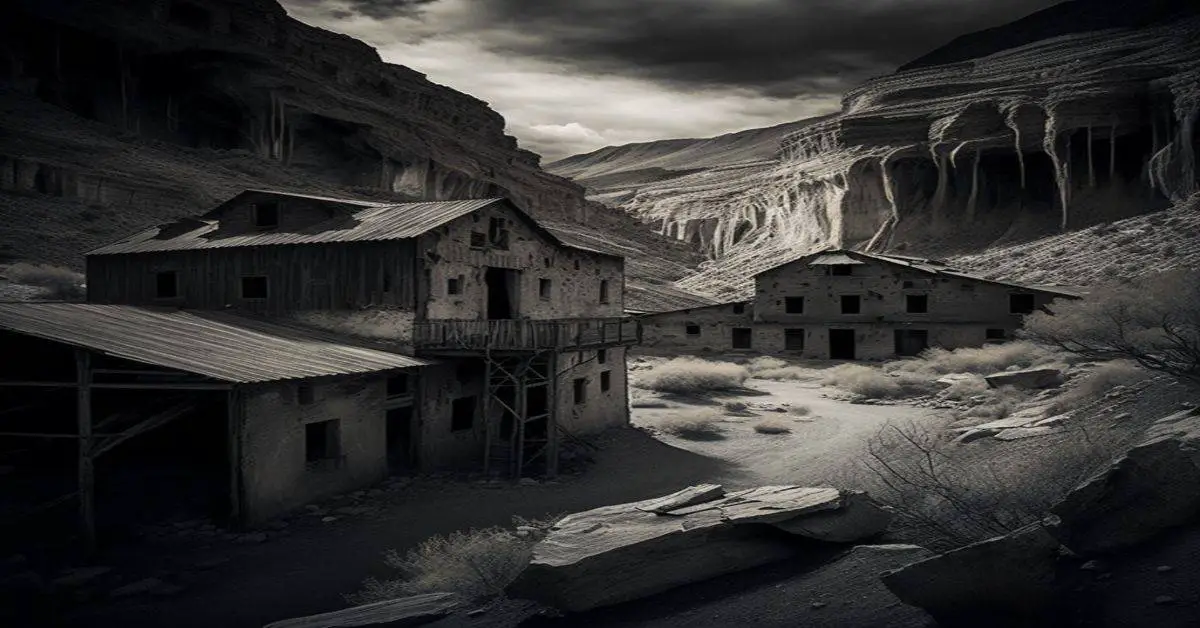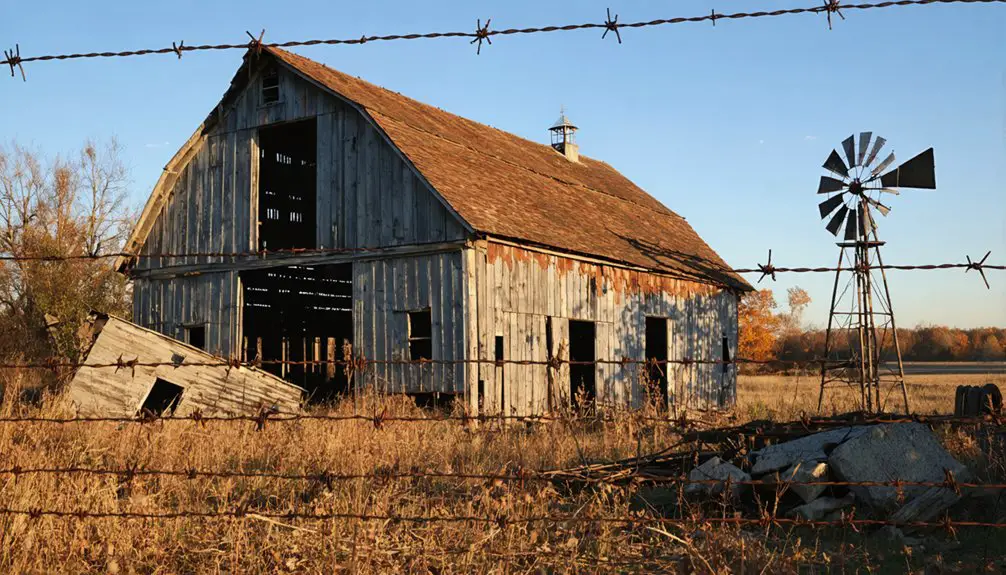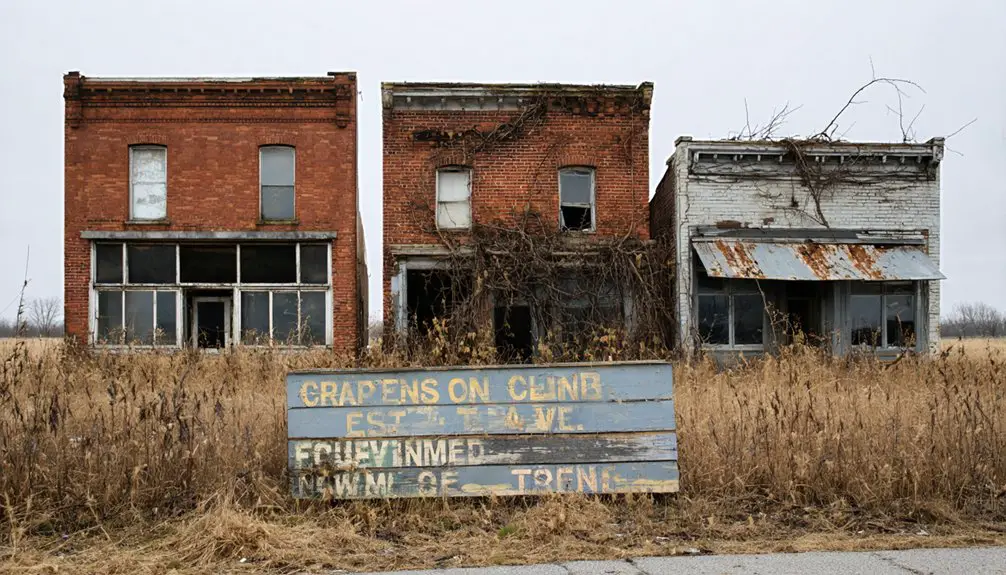You’ll find the ghost town of Sprucevale within Beaver Creek State Park, Ohio, where Quaker settlers established a thriving mill community in the early 1800s. The town centered around Hambleton’s Mill, built in 1813, and briefly prospered during the Sandy & Beaver Canal era. After the canal’s devastating reservoir failure in 1852, Sprucevale’s population dwindled until its complete abandonment by 1870. The haunting stone arches of Hambleton’s Mill still whisper tales of frontier ambition and sudden decline.
Key Takeaways
- Sprucevale was a thriving Ohio mill town established in 1813 around Hambleton’s Mill before becoming completely abandoned by 1870.
- The town’s decline began after the Sandy & Beaver Canal’s reservoir failure in 1852, which devastated local transportation and commerce.
- Hambleton’s Mill, with its distinctive stone arches, remains the last visible structure of the former settlement in Beaver Creek State Park.
- The community once supported 20 families and included a mill, general store, post office, and various shops before its abandonment.
- The ghost town ruins are accessible through Beaver Creek State Park at coordinates 40.706875, -80.580919 via hiking trails.
The Rise of a Quaker Settlement
As Quakers migrated westward from Pennsylvania in the early 1800s, Ohio became a prime destination for their expanding settlements. You’ll find that by 1800, more than 800 Quakers had established new lives in the region, often purchasing land at $2.50 per acre through installment plans.
These settlers followed a strategic pattern: scout parties would first locate suitable land before bringing their families.
Before committing their families to a new life, Quaker scouts meticulously searched for promising lands in Ohio’s untamed wilderness.
In their pursuit of freedom, Quakers prioritized building tight-knit communities centered around their religious values. You’ll discover they established Friends Meetings as central gathering places, emphasizing mutual cooperation and peaceful living. Their commitment to peaceful Indian relations shaped their settlement patterns.
When Sprucevale emerged in 1835, it exemplified these community values through the Hambleton family’s leadership, who developed mills and businesses while maintaining the settlement’s Quaker principles of commerce and social harmony. The small grist mill operated by James Hambleton became the cornerstone of the settlement’s early economic activity.
Life Along Beaver Creek
Three distinct forks of Beaver Creek carved through the rugged valleys of Eastern Ohio and Western Pennsylvania, creating a pristine watershed that would shape frontier life.
You’d find thriving settlements dotting the creek’s 36-mile stretch of wild and scenic waters, where gristmills, sawmills, and paper mills powered local commerce. Community stories centered around places like Gaston’s Mill, built in 1837, while general stores, taverns, and blacksmith shops served as gathering spots for residents. The Ohio Paper Mill operated near Little Beaver Bridge from 1807 until the early 1830s, contributing to the area’s industrial growth.
The area experienced forty years of warfare as American frontiersmen first arrived in the late 1700s.
The creek’s cultural heritage lives on through rich folktales and legends, from the haunting tale of Esther Hale to mysteries surrounding Indian Rock petroglyphs.
These narratives emerged from the region’s turbulent frontier wars and canal era, preserving the spirit of early settlements even as they faded into ghost towns.
Hambleton’s Mill: The Heart of Commerce
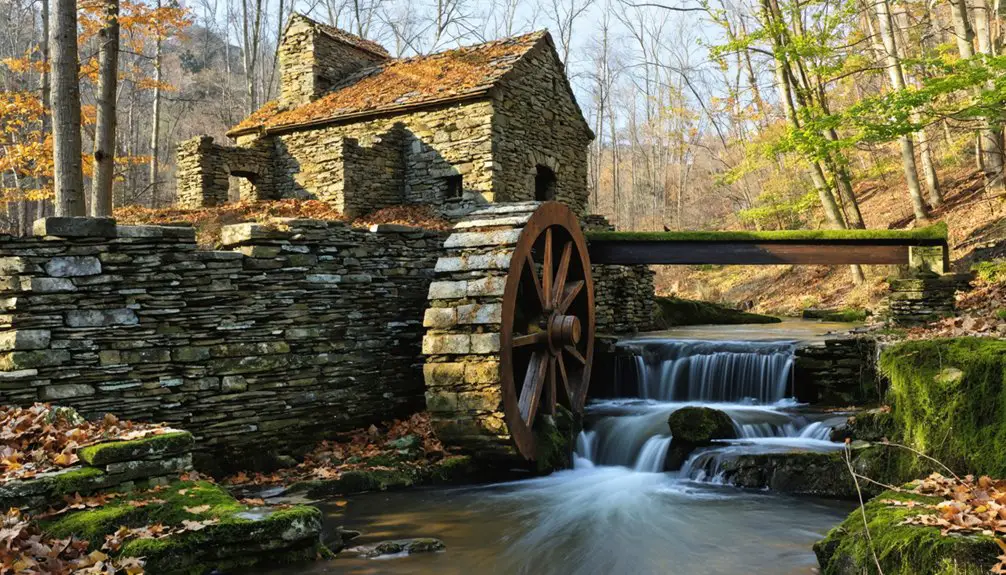
Among the mills that once dotted Beaver Creek’s landscape, Hambleton’s Mill stood out as a symbol of early American ingenuity and commerce. Built in 1813 by James Hambleton, the mill’s architecture featured two stone arches that channeled the creek’s flow beneath the structure, powering its essential grain-processing operations.
You’ll find Hambleton’s legacy deeply woven into Sprucevale’s rise as a thriving community, where the mill anchored a bustling village of twelve homes, a post office, wool factory, and various shops. The mill’s success drew other businesses, creating a self-sustaining economy until the Sandy and Beaver Canal’s decline led to its eventual abandonment by 1870. The area gained further notoriety as the setting for the tragic tale of the Bride at the Bridge. Located within Beaver Creek State Park, the historic site now welcomes visitors year-round.
Today, while the restored mill ruins stand as the last remnant of Sprucevale, they continue to tell the story of this once-vibrant commercial hub.
The Sandy & Beaver Canal Era
When the Ohio legislature chartered the Sandy & Beaver Canal in 1828, they envisioned an ambitious 90-mile waterway connecting the Ohio & Erie Canal at Bolivar to the Ohio River at Glasgow, Pennsylvania.
You’ll find that canal engineering began in 1834, featuring plans for 7 aqueducts and 100 locks. Construction challenges emerged immediately, with the Panic of 1837 devastating the workforce, reducing it from 2,000 to just 200 workers. The final canal design included thirty-three locks along its 73-mile route. The construction project stretched across nearly twenty years to complete.
Though they completed both the Little Tunnel in 1846 and Big Tunnel in 1848, water level issues plagued the middle section. Despite incorporating 30 dams and 3 reservoirs, including Guilford Lake, the canal never achieved consistent commercial traffic.
The final blow came in 1852 when the Cold Run Reservoir Dam broke, causing irreparable damage and ending the canal’s brief four-year operational life.
Daily Life in a Thriving Mill Town
Life in Sprucevale centered around Hambleton’s Mill, established in 1813 by the enterprising Hambleton brothers as the town’s economic foundation. The daily routines of about 20 families revolved around various industries operated by the Hambletons, including a wool factory, sawmill, oil mill, and locksmith shop.
The town’s location along the Sandy and Beaver canal made it an important shipping point for local goods. Family dynamics were shaped by the division of labor among the Hambleton brothers: James ran the grist mill, Charles managed the general store and post office, Benjamin oversaw the sawmill and oil mill, and Isaac operated the wool factory.
You’d find townspeople busy with physically demanding work – from milling grain and processing wool to farming and tending livestock. While the mill operations drove the economy, the general store served as the heart of community life, where you’d gather for trading and socializing. Like many Ohio ghost towns that emerged during the coal mining era, Sprucevale’s economic activities helped sustain the local population.
The Legend of Esther Hale
While Sprucevale’s mill operations kept the town bustling with daily commerce, a haunting tale from 1837 would forever mark its legacy.
On August 12, a young bride named Esther Hale prepared for her wedding day, but her fiancé never arrived. Esther’s heartbreak led to her untimely death, transforming her into a legendary figure known as the White Lady of Sprucevale.
- Esther appears as a ghostly bride near the town’s abandoned bridges and canal remnants
- Local folklore connects her story to other regional legends like Gretchen’s Lock
- Ghostly sightings often occur near Hambleton’s grist mill ruins
- Her tale exemplifies the hardships of frontier life in early Ohio settlements
- The legend lives on through paranormal investigations and historical tours
Today, Esther’s story serves as a poignant reminder of Sprucevale’s past, drawing curious visitors to the ghost town’s remaining structures.
Decline of a Once-Bustling Community
Despite its promising beginnings in 1835, Sprucevale’s prosperity proved short-lived as a devastating reservoir break in 1852 marked the start of its decline.
The once-thriving town of Sprucevale saw its hopes wash away when the reservoir failed in 1852, beginning its slow descent into obscurity.
You’d find the Sandy & Beaver Canal‘s deterioration dealt the first major blow, cutting off essential transportation routes that once brought life to the town’s mills and factories.
As rail lines bypassed Sprucevale, you can trace how the economic shifts devastated local businesses.
Hambleton’s Mill, the town’s cornerstone, couldn’t survive without reliable shipping routes. One by one, the general stores closed, families moved away, and abandoned structures began dotting the landscape.
By 1870, what you’d once recognize as a bustling community of 20 families had vanished entirely.
Today, only scattered ruins remain where this once-promising settlement stood, slowly being reclaimed by the surrounding forest.
Exploring the Ruins Today
Hidden within Beaver Creek State Park in Columbiana County, Ohio, you’ll find the haunting remnants of Sprucevale’s past at coordinates 40.706875, -80.580919.
Your ruin exploration journey leads through rugged terrain and sandstone cliffs to discover Hambleton’s Mill, the last visible structure of this forgotten town.
- Stone archways from the mill’s water channel stand as silent witnesses to industrial heritage
- Dense forest vegetation has reclaimed most building foundations
- No formal facilities exist near the ruins, requiring self-reliant exploration
- Natural hiking trails provide access while preserving historical authenticity
- Photography opportunities abound among architectural remains and scenic vistas
Today’s historical preservation efforts maintain the site in its natural state, allowing you to experience the raw beauty of decay while traversing through wooded paths that reveal Sprucevale’s mysterious past.
Frequently Asked Questions
Were Any Artifacts From the Original Settlement Ever Recovered From the Site?
Perpetually puzzling preservation patterns show you’ll find no formally documented artifact discoveries at this site. While mill ruins remain visible, there’s no record of recovered historical items from systematic archaeological work.
What Happened to the Descendants of Sprucevale’s Founding Families?
You’ll find that founding family legacies dispersed as descendants moved to nearby towns with better economic prospects. They didn’t maintain distinct community ties, though historical preservation keeps their early settlement story alive.
Did Any Other Industries Attempt to Establish Themselves After the Mill Closed?
After the mill’s closure in 1870, you’ll find no documented industrial attempts in the area. The lack of rail connections and collapsed canal infrastructure made it impossible for any failed ventures to overcome economic challenges.
What Native American Tribes Originally Inhabited the Sprucevale Area?
You’ll find that Native tribes like the Erie, Shawnee, and Wyandot historically dominated this land, with the Erie being displaced by 1654, followed by Shawnee settlements and Wyandot influence.
Were There Any Documented Crimes or Notable Incidents During Sprucevale’s Active Years?
Like a blank canvas untouched by shadow, you won’t find crime records from those years. Beyond Esther Hale’s haunting tale of abandonment in 1837, no notable incidents were documented during active times.
References
- https://ohiodnr.gov/go-and-do/plan-a-visit/find-a-property/hambleton-s-mill
- http://www.eastliverpoolhistoricalsociety.org/sandybeavercanal/sandybeavercanal.htm
- https://ohioghosttowns.org/columbiana-county/
- https://www.ghosttowns.com/states/oh/sprucevale.html
- https://www.ghostsofohio.org/lore/ohio_lore_11.html
- https://ohioghosttowns.org/top-10-haunted-towns/
- https://resources.ohiohistory.org/ohj/search/display.php?page=36&ipp=20&searchterm=Array&vol=83&pages=220-255
- http://rainbowrobstravels.blogspot.com/2011/05/quakers-6-gathering-storm-ohio.html
- https://www.ohiogenealogyexpress.com/preble/prebleco_hist_1881/prebleco_hist_1881_0185_gratis_twpx.htm
- http://files.lib.byu.edu/family-history-library/research-outlines/NonGeographic/Quaker.pdf
